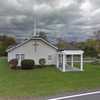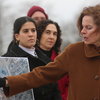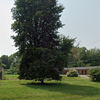‘Holding up a mirror’: FMS reflects on itself for continual improvement
GUILDERLAND — On Monday, the first day of Ramadan, information about the Muslim holiday was shared with staff at Farnsworth Middle School.
“We want them to consider this is the second year our Muslim students have to have Ramadan under the existing social guidelines and COVID restrictions,” said Michael Laster, the princial of the middle school.
The month of fasting, prayer, reflection, and community is one of the Five Pillars of Islam.
“What does that mean for our students?” Laster said faculty was encouraged to consider. “Think about that over the next few weeks as our students practicing Ramadan are again challenged by the additional burden of COVID stuff.”
One of the things Laster is proudest of in Farnsworth’s recent third re-designation as an Essential Elements: Schools to Watch is the middle school’s emphasis on inclusion.
The designation, given to 16 schools statewide this year, is awarded to exceptional middle-level schools that meet rigorous criteria and are on a path of continuous improvement, according to the State Education Department, which makes the decision on designation in partnership with the New York State Middle School Association and the Statewide Network of Middle Level Liaisons.
Farnsworth was first named a School to Watch in 2012 when Mary Summermatter was principal. Since then, Laster has kept up the tradition, reapplying every three years.
“The framework can be used to hold up a mirror ...,” Laster told The Enterprise on Monday. “You’re making sure that it’s excellent, that it’s up to date, that it’s best practices for middle-level learners.”
Laster said he values the continual reflection and improvement both as a principal and as a parent who had two children go through the school.
Completing the process was a challenge in the midst of the pandemic but, Laster said, it also showed some of the school’s strengths.
Before the school was shut down on Mach 13, 2020 to prevent the spread of COVID-19, a committee was already in place to work on the application process and the national organization extended the deadline, he said.
He credited the families, students, and staff who worked on the application “because it takes a village,” he said, referencing a proverb attributed to African cultures, meaning an entire community must be involved in raising children.
“Going through the reapplication process during the pandemic, I realized how much we actually have here that supports middle school kids,” said Laster. “When all the students were not live in front of you any more, you really had to think about: What are the supports we have in place? What are the different programs we have to support learners? How are we supporting our teachers in this new environment?”
He concluded, “So it really helped with the conversations we were having.”
The process of self-analysis and self-evaluation is ongoing at the school; it doesn’t end with a citation.
“Once you identify areas of growth, you focus on what we can get batter at,” said Laster.
For Farnsworth, he said, “One of the pillars is social equity … Something that’s always on our minds as educators here is make sure we are inclusive … We did a lot of work with the culturally responsive framework that came out of State Ed,” he said of the State Education Department.
The building cabinet at Farnsworth, which is made up of stakeholders including teachers, staff, parents, and administrators, formalized goals during the 2015-16 school year to focus on culturally responsive teaching, he said.
In recent years, Farnworth like other Guilderland schools has worked with Stacy Williams, a cultural diversity expert from Marist College. “I’m pretty proud of that work,” said Laster. “We’ve actually had two of our teachers present at a national conference.”
One of the building cabinet’s goals this year, Laster said, is to increase awareness of implicit bias and work toward antiracism. “As a school community, we’ve been doing book studies and working with professors.”
He went on, “The district’s demographics are changing quite a bit so we’re constantly trying to make sure that what we’re doing here reflects the cultures, the religions of the students that we serve and the families that we serve.”
Asked about the faculty, which is largely white and Christian, Laster said, “One of the difficulties with many districts of our demographics is how do we attract and retain teachers who reflect the population we’re serving and that’s something we have to work on.”
Laster said the district is focused on “strategic actions to attract and retain educators that look like the students we have here.”
He also said, “We have recognized that because we’re white, Christian … we have to pay attention to these things because, if we don’t, it gets into that implicit bias work that we’ve been looking at. We’re not even realizing some of the things that we’re doing or saying or acting and how it’s perceived by others.”
Laster concluded, “Ultimately, what we’re trying to do here is provide a safe, inclusive environment for all of our kiddos regardless of their race, religion, culture … The work is never going to be done. It is something we’ll continue and, because of the Schools to Watch process, we’ll be examining ourselves every three years again and asking those questions.”



